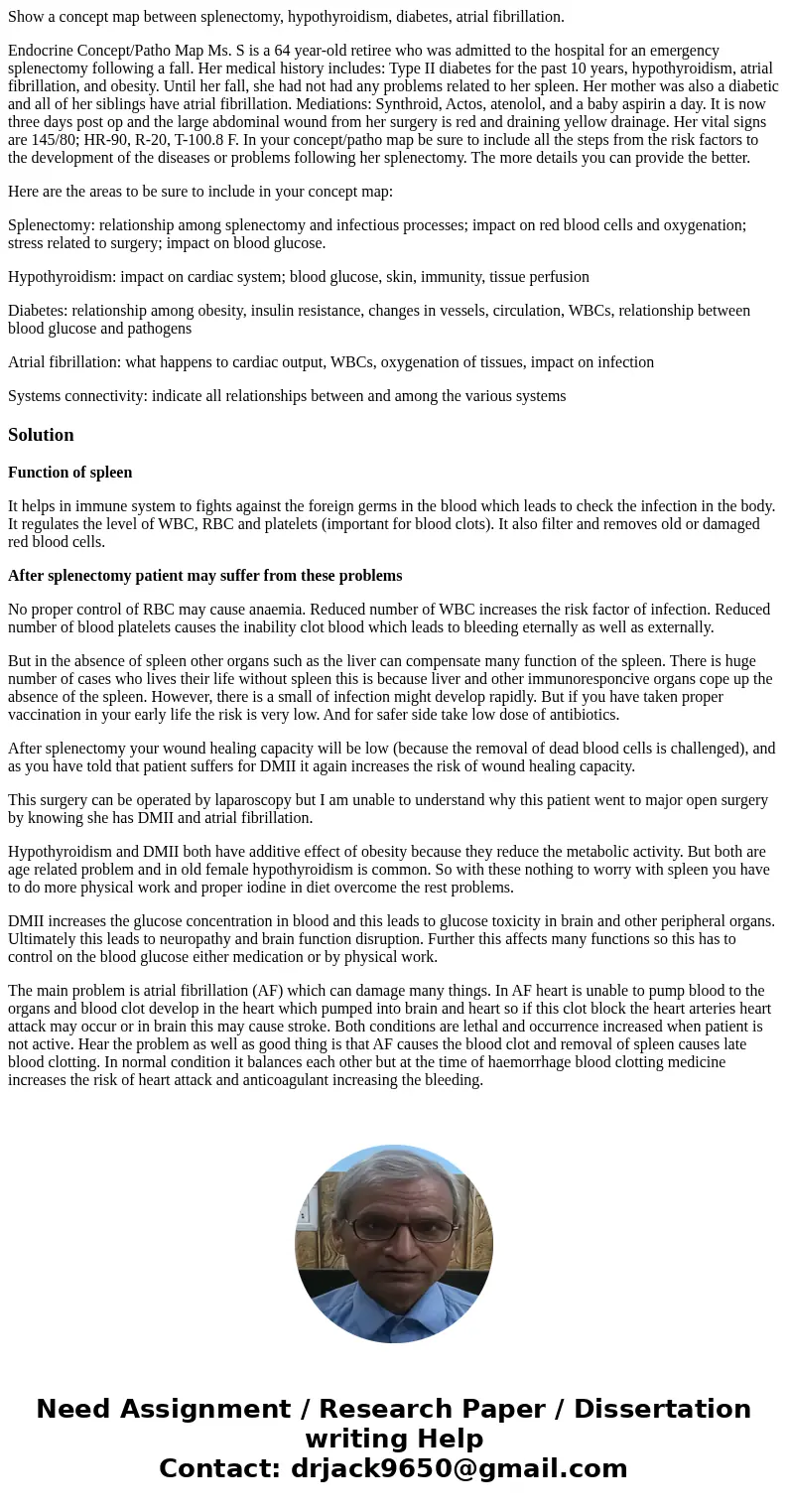Show a concept map between splenectomy hypothyroidism diabet
Show a concept map between splenectomy, hypothyroidism, diabetes, atrial fibrillation.
Endocrine Concept/Patho Map Ms. S is a 64 year-old retiree who was admitted to the hospital for an emergency splenectomy following a fall. Her medical history includes: Type II diabetes for the past 10 years, hypothyroidism, atrial fibrillation, and obesity. Until her fall, she had not had any problems related to her spleen. Her mother was also a diabetic and all of her siblings have atrial fibrillation. Mediations: Synthroid, Actos, atenolol, and a baby aspirin a day. It is now three days post op and the large abdominal wound from her surgery is red and draining yellow drainage. Her vital signs are 145/80; HR-90, R-20, T-100.8 F. In your concept/patho map be sure to include all the steps from the risk factors to the development of the diseases or problems following her splenectomy. The more details you can provide the better.
Here are the areas to be sure to include in your concept map:
Splenectomy: relationship among splenectomy and infectious processes; impact on red blood cells and oxygenation; stress related to surgery; impact on blood glucose.
Hypothyroidism: impact on cardiac system; blood glucose, skin, immunity, tissue perfusion
Diabetes: relationship among obesity, insulin resistance, changes in vessels, circulation, WBCs, relationship between blood glucose and pathogens
Atrial fibrillation: what happens to cardiac output, WBCs, oxygenation of tissues, impact on infection
Systems connectivity: indicate all relationships between and among the various systems
Solution
Function of spleen
It helps in immune system to fights against the foreign germs in the blood which leads to check the infection in the body. It regulates the level of WBC, RBC and platelets (important for blood clots). It also filter and removes old or damaged red blood cells.
After splenectomy patient may suffer from these problems
No proper control of RBC may cause anaemia. Reduced number of WBC increases the risk factor of infection. Reduced number of blood platelets causes the inability clot blood which leads to bleeding eternally as well as externally.
But in the absence of spleen other organs such as the liver can compensate many function of the spleen. There is huge number of cases who lives their life without spleen this is because liver and other immunoresponcive organs cope up the absence of the spleen. However, there is a small of infection might develop rapidly. But if you have taken proper vaccination in your early life the risk is very low. And for safer side take low dose of antibiotics.
After splenectomy your wound healing capacity will be low (because the removal of dead blood cells is challenged), and as you have told that patient suffers for DMII it again increases the risk of wound healing capacity.
This surgery can be operated by laparoscopy but I am unable to understand why this patient went to major open surgery by knowing she has DMII and atrial fibrillation.
Hypothyroidism and DMII both have additive effect of obesity because they reduce the metabolic activity. But both are age related problem and in old female hypothyroidism is common. So with these nothing to worry with spleen you have to do more physical work and proper iodine in diet overcome the rest problems.
DMII increases the glucose concentration in blood and this leads to glucose toxicity in brain and other peripheral organs. Ultimately this leads to neuropathy and brain function disruption. Further this affects many functions so this has to control on the blood glucose either medication or by physical work.
The main problem is atrial fibrillation (AF) which can damage many things. In AF heart is unable to pump blood to the organs and blood clot develop in the heart which pumped into brain and heart so if this clot block the heart arteries heart attack may occur or in brain this may cause stroke. Both conditions are lethal and occurrence increased when patient is not active. Hear the problem as well as good thing is that AF causes the blood clot and removal of spleen causes late blood clotting. In normal condition it balances each other but at the time of haemorrhage blood clotting medicine increases the risk of heart attack and anticoagulant increasing the bleeding.

 Homework Sourse
Homework Sourse